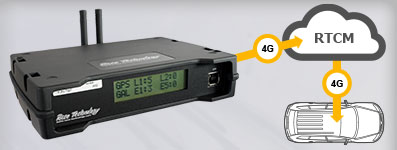Base Station Options
 |
 |
||
| RTK BASE | RTK BASE Portable | ||
| The RTK BASE is a permanently installed RTK base station for generating RTCM corrections locally. | RTK BASE Portable is a temporarily installed base station for generating RTCM corrections locally to the testing environment |
||
For a quotation on this product, enter email address here:
|
For a quotation on this product, enter email address here:
|
Using a local base station increases the positional accuracy of RT CONNECT and GNSS2 systems over the commercial corrections. This local base station can be a permanently installed RTK BASE unit, or a temporarily installed RTK BASE Portable.
The RTK BASE Portable can be operated in either absolute or relative positioning. The permanently installed RTK BASE unit can only be operated in absolute positioning mode.
| Absolute Positioning | Relative Positioning | |||
| Product | RTK BASE and RTK BASE Portable | RTK BASE Portable | ||
| Overview | The position of the base station is fixed to an accuracy of a few mm |
The position of the base station is fixed with an accuracy of up to 1m and can be different from previous tests |
||
| Pros: | Allows results to be compared from previous results, or overlaid on high accuracy maps. Position of the vehicle can be compared with the exact position of surveyed assets, e.g. speed bumps, signs, cones, road lines etc. | The base station can calculate its approximate position quickly, typically just a few minutes. | ||
| Cons: | It takes about 48 hours for the base station to survey its location to millimetre accuracy | The positional accuracy is still accurate to 2cm, but only relative to the base station’s position. If the base station’s location absolute position was in error by 50cm, then the positions of the connected devices are also offset by the same amount. Positions of fixed objects need setting up each time the system is used as the reported positions can be different from one day to the next. |
||
| Typical application | An absolute position is required when the positions of objects needs to be known from one test to the next, over a large period of time. It requires permanent power and somewhere for the unit to be able to run for days at a time. | When the position of the target object and vehicle are important relative to each other, but not to any fixed/immovable objects, or when there is more limited time available for setting up the system. |
 Basket (0)
Basket (0)